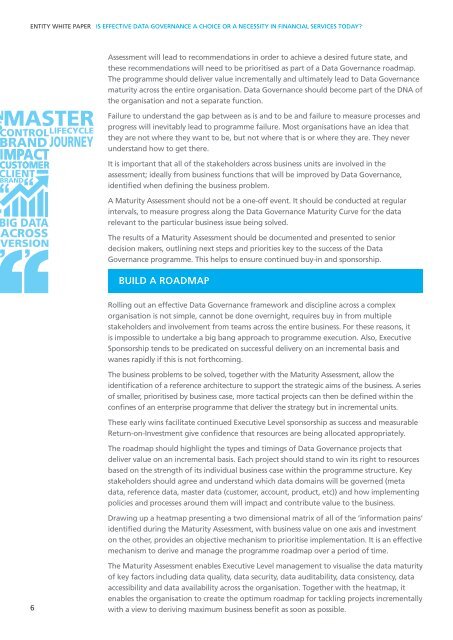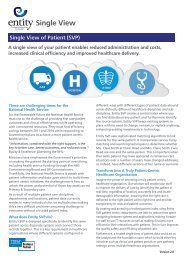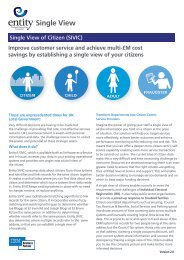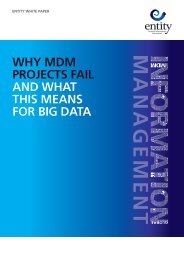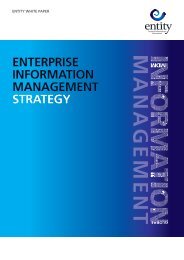MDM_Whitepaper_EDG_Finance
You also want an ePaper? Increase the reach of your titles
YUMPU automatically turns print PDFs into web optimized ePapers that Google loves.
ENTITY WHITE PAPER IS EFFECTIVE DATA GOVERNANCE A CHOICE OR A NECESSITY IN FINANCIAL SERVICES TODAY?<br />
Assessment will lead to recommendations in order to achieve a desired future state, and<br />
these recommendations will need to be prioritised as part of a Data Governance roadmap.<br />
The programme should deliver value incrementally and ultimately lead to Data Governance<br />
maturity across the entire organisation. Data Governance should become part of the DNA of<br />
the organisation and not a separate function.<br />
Failure to understand the gap between as is and to be and failure to measure processes and<br />
progress will inevitably lead to programme failure. Most organisations have an idea that<br />
they are not where they want to be, but not where that is or where they are. They never<br />
understand how to get there.<br />
It is important that all of the stakeholders across business units are involved in the<br />
assessment; ideally from business functions that will be improved by Data Governance,<br />
identified when defining the business problem.<br />
A Maturity Assessment should not be a one-off event. It should be conducted at regular<br />
intervals, to measure progress along the Data Governance Maturity Curve for the data<br />
relevant to the particular business issue being solved.<br />
The results of a Maturity Assessment should be documented and presented to senior<br />
decision makers, outlining next steps and priorities key to the success of the Data<br />
Governance programme. This helps to ensure continued buy-in and sponsorship.<br />
BUILD A ROADMAP<br />
Rolling out an effective Data Governance framework and discipline across a complex<br />
organisation is not simple, cannot be done overnight, requires buy in from multiple<br />
SOLUTION<br />
stakeholders and involvement from teams across the entire business. For these reasons, it<br />
is impossible to undertake a big bang approach to programme execution. Also, Executive<br />
Sponsorship tends to be predicated on successful delivery on an incremental basis and<br />
wanes rapidly if this is not forthcoming.<br />
The business problems to be solved, together with the Maturity Assessment, allow the<br />
identification of a reference architecture to support the strategic aims of the business. A series<br />
of smaller, prioritised by business case, more tactical projects can then be defined within the<br />
confines of an enterprise programme that deliver the strategy but in incremental units.<br />
These early wins facilitate continued Executive Level sponsorship as success and measurable<br />
Return-on-Investment give confidence that resources are being allocated appropriately.<br />
The roadmap should highlight the types and timings of Data Governance projects that<br />
deliver value on an incremental basis. Each project should stand to win its right to resources<br />
based on the strength of its individual business case within the programme structure. Key<br />
stakeholders should agree and understand which data domains will be governed (meta<br />
data, reference data, master data (customer, account, product, etc)) and how implementing<br />
policies and processes around them will impact and contribute value to the business.<br />
Drawing up a heatmap presenting a two dimensional matrix of all of the ‘information pains‘<br />
identified during the Maturity Assessment, with business value on one axis and investment<br />
on the other, provides an objective mechanism to prioritise implementation. It is an effective<br />
mechanism to derive and manage the programme roadmap over a period of time.<br />
6<br />
The Maturity Assessment enables Executive Level management to visualise the data maturity<br />
of key factors including data quality, data security, data auditability, data consistency, data<br />
accessibility and data availability across the organisation. Together with the heatmap, it<br />
enables the organisation to create the optimum roadmap for tackling projects incrementally<br />
with a view to deriving maximum business benefit as soon as possible.


